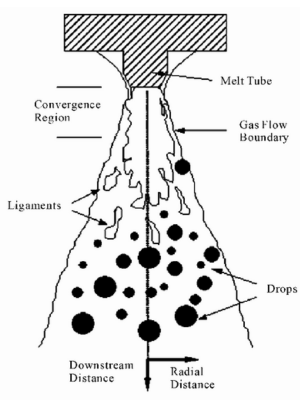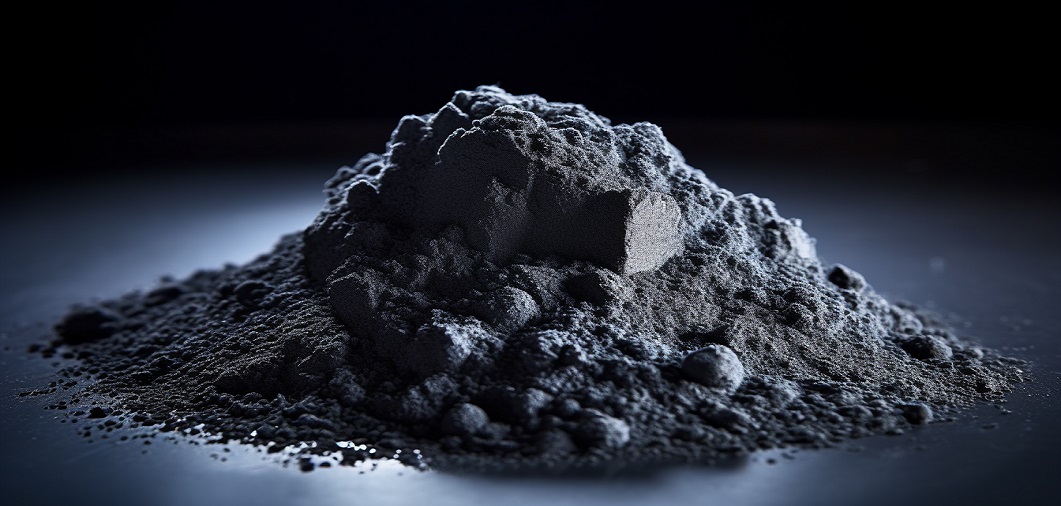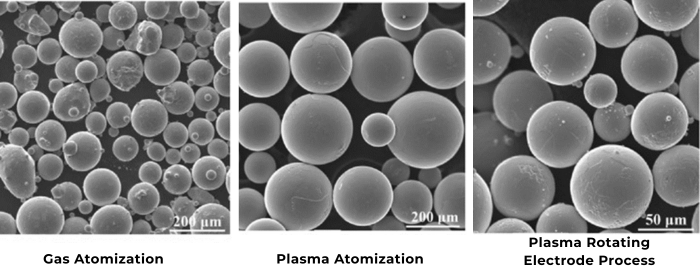

Metal powder, especially spherical metal powder, is a vital raw material in additive manufacturing. Among the many powder preparation processes, gas atomization stands out because of its unique advantages. It is the main choice for preparing spherical powder. This article will help readers understand the advantages of spherical powder in additive manufacturing and explore the characteristics, types, and challenges of the gas atomization preparation process in depth.
Metal powders are vital raw materials in additive manufacturing, and their quality greatly determines the final product's performance. With the rapid development of additive manufacturing technology and its specific process requirements, the quality demands for metal powders are increasing, such as high sphericity, good flowability, and low gas and impurity content. Spherical powders have unparalleled advantages in additive manufacturing over other shapes:
.png)
Fig 1. Spherical powders and irregular powders
Currently, methods for producing metal powders include atomization, mechanical crushing, rotating electrodes, electrochemical corrosion, and reduction methods. Among these, only gas atomization (GA) and plasma rotating electrode process (PREP) can directly produce spherical powders.[[1]]
Other methods require additional processing to obtain near-spherical powders. PREP produces powders with high sphericity, but due to process limitations, the yield of fine powders is low, making it mainly suitable for producing feedstock powders for additive manufacturing.
In contrast, gas atomization technology produces powders with high sphericity, good flowability, and low O, N, and H content. Moreover, the particle size distribution of the powders produced by this method is highly controllable. Considering these advantages, gas atomization has become the primary method for producing high-performance spherical metal powders.
A major advantage of gas atomization is its ability to produce powders with excellent sphericity and flowability, which are crucial for many applications, such as additive manufacturing. The gas atomization process involves breaking liquid metal into fine droplets through gas shearing and extrusion as the metal falls under gravity. Once the droplets leave the effective atomization zone, the external pressure on the droplets decreases sharply, causing self-induced fragmentation due to the imbalance of internal and external pressures.

Fig 2. The principle of gas atomization[[2]]
This method uses ultrasonic vibrations and gas flow to produce metal powders. High-frequency vibrations generated by an ultrasonic generator break up molten metal into fine droplets, which are then further atomized by high-speed gas flow into powder. The process is characterized by energy concentration in a small area, effective atomization, and relatively simple equipment, suitable for small-scale production.
Powders produced by ultrasonic gas atomization are fine and uniform, typically ranging from a few microns to tens of microns. It is particularly suitable for preparing low-melting-point metals and alloys such as aluminum and magnesium.
This method uses high-pressure gas (typically over 1 MPa) to atomize molten metal. The high-speed jet of gas directly impacts the molten metal stream, breaking it into fine particles. The strong shear and impact forces of the high-pressure gas effectively disperse the molten metal into powder. High-pressure gas atomization is characterized by high atomization efficiency, the ability to produce small and uniform powder particles, and suitability for large-scale production.
The powder particle size typically ranges from 10 to 100 microns, and the particle shape is nearly spherical. This method is suitable for producing high-melting-point and high-purity metal and alloy powders such as titanium alloys, aluminum alloys, and stainless steel.
This method uses laminar gas flow to atomize molten metal. By controlling the gas flow state to maintain the laminar flow rather than a turbulent flow, stable shearing and stretching actions are applied to the molten metal stream, dispersing it into fine particles. Laminar flow gas atomization is characterized by a stable atomization process, uniform powder particle size distribution, and good control over powder shape.
The powder particle size typically ranges from 20 to 100 microns, with a narrow size distribution and nearly spherical shape. This method is suitable for producing metal and alloy powders that require strict control over shape and particle size, such as high-quality stainless steel, titanium alloys, and aluminum alloys.
This method uses heated gas (usually inert gases like argon or nitrogen) to atomize molten metal. The heated gas reaches high temperatures and is then rapidly injected to impact the molten metal, breaking it into fine particles. The high temperature of the gas enhances the fluidity of the molten metal and improves atomization efficiency. The powder particle size typically ranges from 20 to 200 microns and is suitable for metals with low melting points like aluminum.
This method combines centrifugal force and gas pressure to atomize molten metal. A high-speed rotating centrifugal disc or nozzle throws out molten metal, forming fine droplets, which are then further atomized by high-pressure gas flow. The centrifugal force and gas shear force together provide effective atomization, producing uniform powder particle size distribution. The powder particle size typically ranges from 10 to 150 microns and can be used for tin alloys.
This method uses electromagnetic induction heating and high-pressure gas to atomize molten metal. Electromagnetic induction heating rapidly and evenly heats the metal to the required temperature, while high-pressure gas breaks the molten metal into fine particles. Electromagnetic induction heating allows precise control over the metal temperature and fluidity, producing powders with particle sizes around 40 microns, suitable for highly reactive metals like high-purity titanium, niobium, and zirconium.
Table 1. Overview of Major Gas Atomization Types
This table shows the characteristics of the above 6 atomization methods, the particle size range of the powder produced, and the applicable powders.
.png)
Gas atomization technology is widely used for producing metal powders but faces several challenges. Controlling the particle size distribution in the gas atomization process is a key challenge. The liquid metal is broken into tiny particles by high-pressure gas impacts, making it difficult to precisely control the size of each particle. This often leads to a broad particle size distribution, which is unfavorable for specific applications.
In addition, a large amount of gas is consumed during the preparation process. The gas atomization process often requires high-pressure gases like argon or nitrogen for atomization, which are expensive and consumed in large quantities, increasing production costs. What matters is the Oxygen content control. During gas atomization, metal powders can easily react with oxygen in the air, increasing the oxygen content of the powder. This affects the physical and mechanical properties of the powder, negatively impacting subsequent applications.
To sum up, gas atomization is a vital method for producing high-quality spherical metal powders for additive manufacturing. Despite its advantages, challenges like particle size control, gas consumption, and oxygen content control need continuous improvement. Advances in this technology will further enhance the performance and application scope of metal powders, driving the development of additive manufacturing and other fields.
Stanford Advanced Materials (SAM) has been committed to providing high-quality atomized metal alloy powders to our valued clients in both commercial and industrial fields. Our wide selection of spherical metal powders includes stainless steel powder, titanium, aluminum, cobalt and nickel alloy powders. These products meet the diverse manufacturing needs across various Powder Metallurgy (PM) technologies, such as Additive Manufacturing (AM), Hot Isostatic Pressing (HIP), and Metal Injection Molding (MIM).
Related reading:
Comparative Analysis of Different Preparation Methods of Spherical Powder
Metal Powders: Different Options for Additive Manufacturing Materials
[1] ANGELO P,SUBRAMANIAN R. Powder metallurgy:science,technology and applications [M]. PHI Learning Pvt.Ltd.,2008.
[2] Antipas, Georgios. (2011). Liquid Column Deformation and Particle Size Distribution in Gas Atomization. International Journal of Computational Materials Science and Surface Engineering. 4. 247-264. 10.1504/IJCMSSE.2011.042822.







